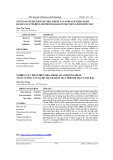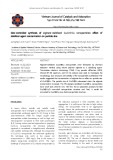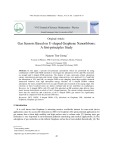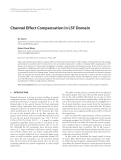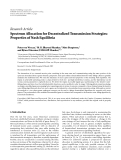
Transmission spectrum
-
Silver nanoparticles (Ag NPs) were synthesized and characterized by transmission electron microscopy (TEM), X-ray powder diffraction (XRD), and absorption spectroscopy. Using Debye-Scherrer’s formula and the result of the XRD spectrum, the size of the Ag NPs was estimated at approximately 8 nm.
 7p
7p  viengfa
viengfa
 28-10-2024
28-10-2024
 0
0
 0
0
 Download
Download
-
Alginate-stabilized Cu2O@Cu nanoparticles were fabricated by chemical reduction method using nature polymer alginate as a stabilizing agent. Transmission electron microscopy (TEM), X-ray powder diffraction (XRD), infrared (FT-IR) spectrum, and UV-Vis analysis were used to investigate the morphology, size, structure, and stability of the nanoparticles synthesized.
 6p
6p  vikwong
vikwong
 29-09-2024
29-09-2024
 5
5
 1
1
 Download
Download
-
In this paper, I present first-principle calculations which are performed by using combination of DFT and NEGF methods to investigate the adsorption of CO2 and NH3 molecules on straight and U-shaped GNRs junctions. The density of state, molecular orbital, adsorption energy, transmission spectrum, and current-voltage characteristics were analyzed.
 8p
8p  tamynhan6
tamynhan6
 14-09-2020
14-09-2020
 32
32
 1
1
 Download
Download
-
EURASIP Journal on Applied Signal Processing 2003:9, 922–929 c 2003 Hindawi Publishing Corporation Channel Effect Compensation in LSF Domain An-Tze Yu Department of Computer Science, National Chubei Senior High School, Chubei, Hsinchu, Taiwan 302, Taiwan Email: yuat@cpshs.hcc.edu.tw Hsiao-Chuan Wang Department of Electrical Engineering, National Tsing Hua University, Hsinchu, Taiwan 300, Taiwan Email: hcwang@ee.nthu.edu.tw Received 15 April 2003 and in revised form 9 May 2003 This study addresses the problem of channel effect in the line spectrum frequency (LSF) domain.
 8p
8p  sting12
sting12
 10-03-2012
10-03-2012
 38
38
 4
4
 Download
Download
-
Tuyển tập báo cáo các nghiên cứu khoa học quốc tế ngành hóa học dành cho các bạn yêu hóa học tham khảo đề tài: Research Article Spectrum Allocation for Decentralized Transmission Strategies: Properties of Nash Equilibria
 11p
11p  dauphong16
dauphong16
 20-02-2012
20-02-2012
 41
41
 3
3
 Download
Download
-
TELECOMMUNICATION TRANSMISSION MEDIA In this chapter the characteristics of the media in which the transmission of signals takes place will be discussed. It so happens that we humans basically communicate through speech=hearing and by sight. Human hearing is from 20 Hz to 20 kHz and we can see only the portion of radiation spectrum from about 4:3 Â 1014 Hz (infrared; l ¼ 7 Â 10À7 m) to approximately 7:5 Â 1014 Hz (ultraviolet; l ¼ 4 Â 10À7 m). These communication channels occupy only small portions of the detectable frequency spectrum which has no lower boundary but has an upper...
 24p
24p  tienvovan
tienvovan
 11-09-2010
11-09-2010
 69
69
 6
6
 Download
Download
-
THE UTRA1 TRANSMISSION SYSTEM UMTS SPECTRUM ALLOCATION The UMTS frequency ranges are part of the world wide spectrum allocation for 3rd or evolving 2nd generation systems. Figure 5.1 illustrates the representation of the spectrum from major regions (e.g. Europe, Japan, Korea, and USA).
 0p
0p  doroxon
doroxon
 12-08-2010
12-08-2010
 86
86
 9
9
 Download
Download
-
the world. First published in 1995, it has been adopted by more than half of all countries in the world. Since the publication of the DVB-T standard, however, research in transmission technology has continued, and new options for modulating and error-protecting broadcast steams have been developed. Simultaneously, the demand for broadcasting frequency spectrum has increased as has the pressure to release broadcast spectrum for non-broadcast applications, making it is ever more necessary to maximise spectrum efficiency....
 25p
25p  khinhkha
khinhkha
 26-07-2010
26-07-2010
 132
132
 31
31
 Download
Download
CHỦ ĐỀ BẠN MUỐN TÌM









